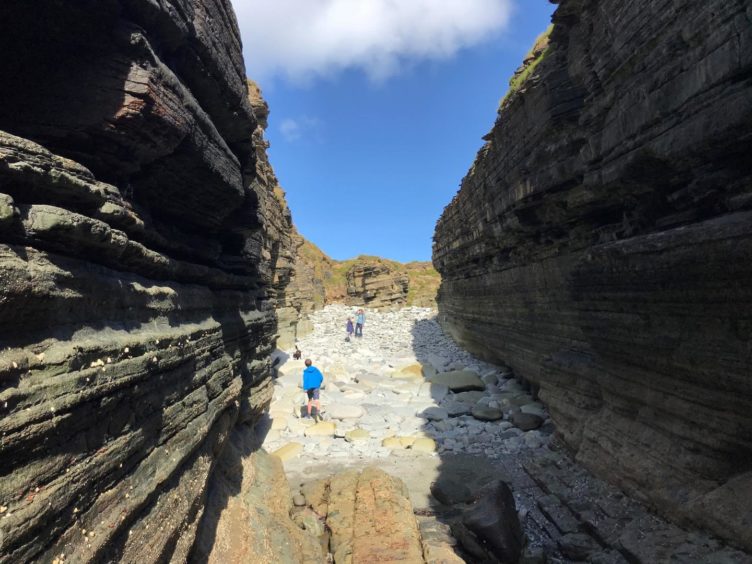Orkney is famed for its archaeology, coastal walks and puffins, as Michael Alexander discovered on a family holiday.
It’s the world famous Neolithic sites of Skara Brae, Ring of Brodgar and Maeshowe that inevitably grab much of the attention from visitors to Orkney.
But just a few miles north of the Bay of Skaill, on the north west tip of the Orkney Mainland, it’s the remarkable remains of a lesser known Norse village and earlier Pictish settlement on the Brough of Birsay that often raise eyebrows of surprise.
The Vikings arrived on the Brough of Birsay during the 9th century and the Norse settlement there was developed over the next three centuries.
The process of building and rebuilding structures has left a complicated maze of stone walls, one on top of the other.
Remains of several Norse longhouses, barns and a smithy can still be seen, as well as an 11th century sauna with underfloor heating.
A small 12th century Romanesque-style church lies at the heart of the Viking settlement – possibly established, the Orkneyinga Saga suggests, by Thorfinn ‘the Mighty,’ Earl of Orkney.
Causeway
Today, visitors access the tidal Brough of Birsay island by a 150 metre long concrete causeway at low tide.
It’s a great place to let the imagination run wild and feels like an adventure just waiting for the tide to recede.
The beach at the Brough is known amongst Orcadians as a good place to search for the shells of the Common Gowrie known as Groatie Buckies (named because they are common at John o’Groats).
There’s an old saying that if you put a Groatie Buckie in your purse, the saying goes that you will never be poor!
Puffins
However, between May and July, the Brough of Birsay is also one of the best places on the Orkney Mainland to see puffins.
After exploring the Viking village, we didn’t have particularly high expectations that we’d see any of the seabirds as we followed the track gently uphill, aiming for David Stevenson’s 1925-built lighthouse which stands high on the cliffs on the back of the island.
Peering over the edge of the steep rising cliffs as we made our way up the track, however, we were amazed to discover dozens of puffins nesting on ledges and cliffside rabbit burrows just a few metres below the cliff edge.
For the next half hour or so, we spent a mesmerising time lying on our bellies about as close to the cliff edge as it was safe to get, making use of my camera’s zoom lens to marvel at the rainbow coloured hues on the bills of the adults.
Having never seen puffins for real before, I was struck by how small they were.
From there we continued our circuit of the island via the Northern Lighthouse Board maintained lighthouse – a reminder, as if one is ever needed on Orkney, that the sea is as powerful as it is beautiful and commands respect.
Second Orkney adventure
This wasn’t our first visit to Orkney, or indeed to the Brough of Birsay.
However, when the pandemic overtook events and forced the postponement of the week’s holiday we had originally booked for Easter 2020, our rescheduled Covid-19 secure return in July last year felt like a major coup.
We stayed in the same self-catering cottage as we did last time at 40 Alfred Street, Stromness – a Scottish heritage site that was once home to Orcadian lifeboat coxswain Robert Greig who was awarded a silver medal for extreme gallantry in 1908.
The former fishermen’s cottage has been beautifully converted into a cosy modern dwelling and, with its own private pier outside, we quickly got into the rhythm of sitting out with a cup of tea – wrapped against the elements – to watch the rise and fall of the tide and to watch the ships roll in, and watch them roll away again…
We were already familiar with the countless walks along the coastal path from Stromness to Warbeth beach with spectacular views across to Hoy and the western entrance to Scapa Flow.
Orkney mainland west coast walks
With an element of wanting to stay away from people as much as possible, however, this trip also saw us discover much more of the stunning walking routes on the west coast of the Orkney Mainland between Stromness and Birsay.
The most spectacular by far was the path heading north and south along the towering cliffs at Yesnaby.
The Brough of Bigging offers spectacular views of the jagged and towering seabird festooned cliffs, while the path continues past rocky inlets to reach Yesnaby Castle – a delicate sea-stack with a natural arch.
Here, we found a great picnic spot, again being incredibly careful not to get too close to the cliff edge.
North of here, we also walked another day from Yesnaby to Bay of Skaill via the Broch of Borwick – an ancient cliff top structure more than 2000-years-old with views towards Marwick Head and, of course, the Brough of Birsay.
Also worth visiting is the Kitchener Memorial which stands silently looking out to sea.
Here, in 1916, the HMS Hampshire sank after hitting a mine en route to Russia.
Among those who lost their lives was Lord Kitchener, minister of war at that time.
A memorial was erected atop the cliffs in honour of all who perished.
*Michael Alexander and family paid for their own holiday. For more information see Orkney.com


















